In the case of the star-crossed dB’s, that pretty much means their entire catalog.
The first and second dB’s records, released in 1981, existed only as foreign imports. The band finally found an American label for its third album, but that imprint lost its distribution deal just as the LP dropped.
R.E.M. invited the group to join its beloved I.R.S. Records for a fourth album, only to ditch the label themselves, whereupon the label “didn’t quite know what to do with the band and the album,” said Peter Holsapple, one of the two principal dB’s songwriters.
Despite it all, the dB’s made a mark on the college radio movement of the 1980s. The band’s debut, Stands for deciBels, endures as a landmark release of the new wave era. That album and the next three all landed on Robert Christgau’s influential Pazz & Jop Critics Poll: Repercussion in 1982, Like This in 1984, and The Sound of Music in 1987.
Four decades later, the dB’s catalog remains in disrepair. The band just released Stands for deciBels on domestic vinyl for the first time. The other albums are out there, but they are in short supply.
Consider The Sound of Music, the neglected I.R.S. release. A recent search on the online marketplace Discogs turned up 110 copies available for sale worldwide, all of them used. You’d have better luck finding a copy of #1 Record, the ironically titled 1972 debut from Big Star, a record that barely reached shelves.
All four original dB’s releases belong in the collection of anyone with serious interest in 1980s alternative music. And if you mourned their breakup, after a desultory Florida show in 1988, you need to hunt down Mavericks, a lovely album released by Holsapple and songwriting partner Chris Stamey in 1991.
Or, you can go and see the band in concert. The dB’s are touring for the first time in more than a decade. We caught them at shows in Raleigh, N.C., and Washington, D.C. Few bands touring in 2024 can boast such a strong batch of original compositions, although we would have loved to hear a bit more from the third and fourth albums.
All four dB’s hailed from North Carolina, but they formed the band in New York. Holsapple wrote Nuggets-style garage-band pop songs. Stamey wrote angular art-rock experiments, more suited to the keyboard adornments of the era.
To conjure a lazy analogy, they weren’t Lennon and McCartney so much as McLennan and Forster, the great Go-Betweens collaborators, one a pop melodicist, the other an edgy art-rocker.
The songs were great, steeped all the right influences – Big Star, the Beach Boys, the Move and the Left Banke – but ultimately transcending those touchstones to express each writer’s singular voice.
“We grew up in Winston-Salem together in the ’60s and ’70s,” Holsapple said. “We had the same radio stations playing in our cars on the way to school. We shopped at the same record stores. We were feeding off the same trough, if you will. Buck Owens, James Brown, Otis Redding. One group that definitely helped show a path was Big Star.”
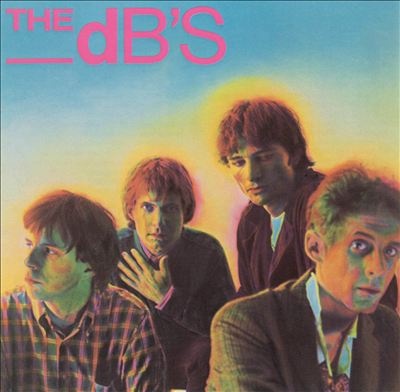 Stands for deciBels – 1981
Stands for deciBels – 1981
The dB’s debut ranks as one of the strongest songwriting efforts of 1981, not far behind Squeeze‘s East Side Story and Prince‘s Controversy.
“Black and White,” the first single, is a jangle-pop gem, anchored by the first of many memorable Holsapple guitar figures. It sounds uncannily like early R.E.M.
Did the bands find their sounds separately?
“They were still in Athens,” Georgia, “and we were already in New York,” Holsapple said. “It just happened that they had a similar sound, I guess.”
“She’s Not Worried,” from Stamey, celebrates the baroque pop of the Left Banke, the Zombies and especially the Beach Boys of the Pet Sounds era.
Holsapple’s “Bad Reputation” offers more delectable guitar figures, evoking Todd Rundgren and early Cheap Trick. “Big Brown Eyes,” all two minutes of it, is a near-perfect concoction of melody, guitar lines and chords.
Yet, no U.S. label would release Stands for deciBels. The record came out on the British Albion Records imprint, available to American consumers only as an expensive import.
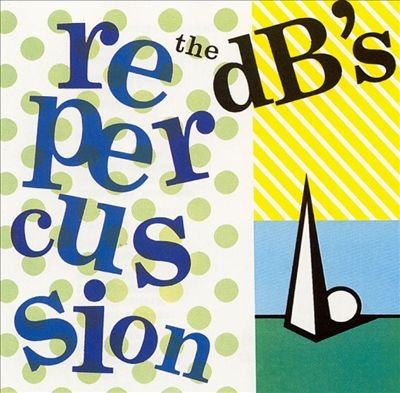 Repercussion – 1982
Repercussion – 1982
The second dB’s record was recorded mostly at Ramport Studios in London, a development that suited the quartet of anglophiles just fine.
“Oh, dude,” Holsapple said. “We were shopping at the Record & Tape Exchange, a couple of times a week. Listening to the Status Quo.”
Like deciBels, Repercussion saw no domestic release. Why, then, does the Discogs marketplace show a U.S. version? Holsapple explains: The British label shipped some copies to the States in advance of a tour. “It had no effect on the sales of the record,” he said.
Repercussion ranks not far below Stands for deciBels in songcraft. “Neverland,” the last and best cut, marshals another brilliant Holsapple riff and a euphoric call-and-answer chorus, all in the service of dissecting a failed relationship. “Amplifier” tells the story of a guy who dies by suicide after a breakup, and plays it for gallows humor, an approach that would be hard to imagine today.
“The lighter side of suicide,” Holsapple said. “There was a more permissive attitude toward stuff.”
Holsapple never quite forgave Scott Litt, the famed R.E.M. producer, for transforming “Nothing Is Wrong” from a Big Star guitar workout into a Procol Harum organ dirge.
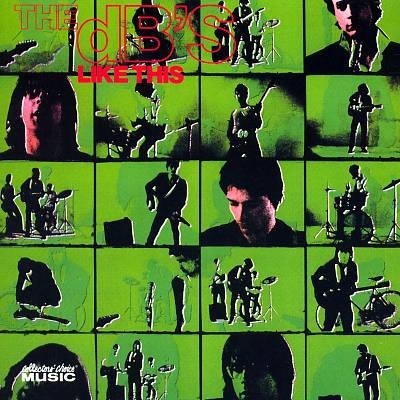 Like This – 1984
Like This – 1984
After Repercussion, Chris Stamey left the dB’s “to do solo stuff,” Holsapple said. “I think he felt constricted by guitar, bass, and drums, which I can dig.”
The third album, Like This, should have been the dB’s breakthrough. The band finally had an American label, Bearsville, longtime home to Todd Rundgren. And Holsapple unfurled his strongest collection of songs to date, admirably compensating for the loss of his partner.
“Without having Chris to play off of with the songwriting, it was quite a lot of work to try to get that together and pick the right songs,” Holsapple said. “We wanted to give ourselves a shot at a commercial kind of record. We were fine with being a new wave band, but we didn’t feel like we were that much different than 38 Special.”
The lead track, “Love Is for Lovers,” was the catchiest dB’s song yet, anchored by another dazzling Holsapple guitar figure. That song and “A Spy in the House of Love” echoed out of many college dorm rooms in 1984. “She Got Soul” was another sad-sack romantic tale, turning on a wicked lyrical double-entendre: “Every girl I know has got some soul/Wrapped around her finger like a twenty-dollar ring.”
But the best song was probably “Lonely Is (As Lonely Does),” built around a haunting guitar arpeggio and a sweetly melodic chorus, and sprinkled with lovely, Difford-and-Tilbrook-style chord inversions. (Holsapple said he learned chord inversions from playing Dylan‘s “Don’t Think Twice, It’s All Right” in childhood.)
Like This probably should have broken out. Yet again, misfortune intervened. On the week of the album’s release, Holsapple said, Bearsville Records lost its distribution deal.
“In the parallel world of the dB’s, business as usual,” he quipped. “We went out and toured with R.E.M, and there were no records in stores.”
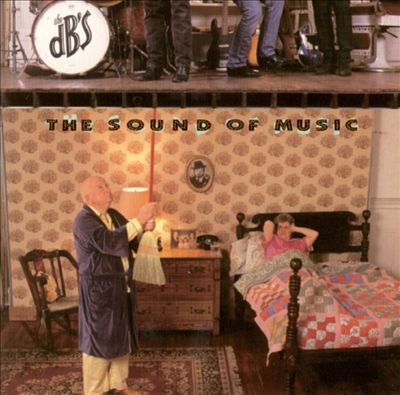 The Sound of Music – 1987
The Sound of Music – 1987
Naturally, more misfortune attended the release of the fourth and final LP from the pre-millennial incarnation of the dB’s.
When the band emerged from legal limbo with Bearsville Records, R.E.M. swept in, inviting them to join I.R.S. Records.
“R.E.M. was like, ‘You should go to I.R.S., they’ll know exactly what to do with you,'” Holsapple said. “And then, R.E.M. left for Warner Brothers. Our big mentor at the label kind of disappeared.”
Of the four original dB’s releases, The Sound of Music seems to be the hardest to find. The Discogs database indicates it has never been reissued. Good luck finding it on iTunes.
“That record is, for all intents and purposes, gone,” Holsapple said.
The Sound of Music is another great collection of songs, nearly the equal of Like This.
“I Lie” is a worthy successor to “Lonely Is,” this time built upon a double-note arpeggio, and ending with a beautiful coda.
“Molly Says” anticipates Freedy Johnston, who, come to think of it, also wrote a great song titled “Bad Reputation.” Listen closely, and you’ll hear that Holsapple starts each line with the next chord in a sequence.
“Music is math, right?” he said.
“Working for Somebody Else” would not sound out of place on Born in the U.S.A. “Change with the Changing Times” should have been a college-radio hit. Singer-songwriter Syd Straw shares the lead on “Never Before and Never Again.”
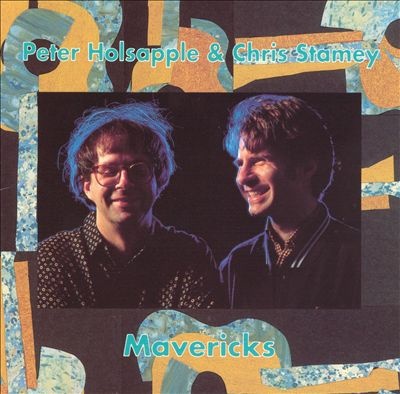 Mavericks – 1991
Mavericks – 1991
The Mavericks LP, recorded by Holsapple and Stamey as a duo, occupies a curious place in the dB’s canon. It came out in 1991, just four years after The Sound of Music, a little too soon for your typical rock-and-roll reunion. But it doesn’t really sound like the fifth dB’s record, either: More like an inspired session of MTV Unplugged.
“Chris [Stamey] was living in Hoboken,” Holsapple said. “I think I came and visited him and had the verses of ‘Angels.’ He finished the song, and we decided it might be fun to do a non-dB’s album.”
Mavericks is a worthy addition to the dB’s catalog. Several tracks, including “Angels,” “I Know You Will” and “I Want to Break Your Heart,” are as strong as any in the band’s repertoire.
The record is remarkably cohesive. At moments, it’s hard to tell the two songwriters apart. Holsapple’s “Anymore” is as artsy and angular as any Chris Stamey song, while Stamey’s “Break Your Heart” sounds like vintage Holsapple.
“My vibe about Mavericks is that our writing styles for that record seemed to switch,” Holsapple said. “Chris was writing rockers like ‘I Want to Break Your Heart,’ and I was going out on a limb with songs like ‘Anymore.’ Just as you said.”
Holsapple and Stamey have released two more album-length collaborations, Here and Now and Our Back Pages. And all four dB’s regrouped for a 2012 release, Falling Off the Sky. All are worth a listen.
Daniel de Visé is a frequent AllMusic contributor and author of King of the Blues: The Rise and Reign of B.B. King and the recent book The Blues Brothers – An Epic Friendship, the Rise of Improv, and the Making of an American Film Classic. Source






